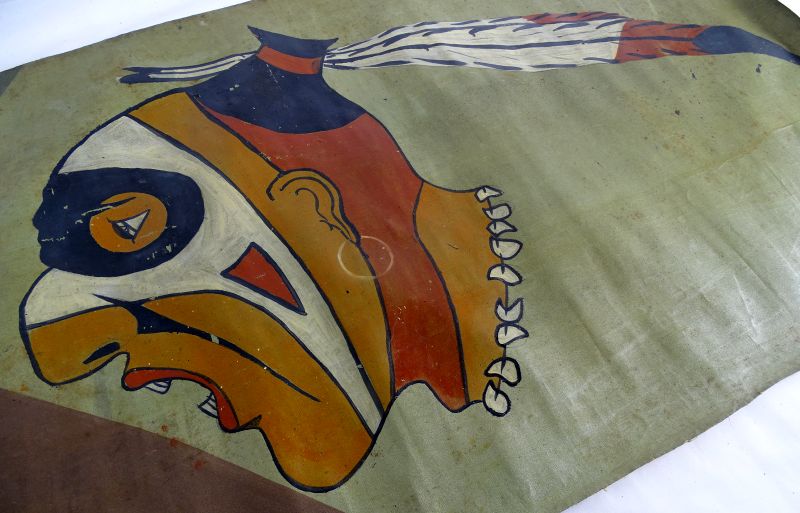WWI 213th Aero Squadron Painted Spad Aircraft Fabric Squadron Insignia 21 Inches by 33 Inches
$7,500.00
The painted fabric squadron insignia was cut from the left side of a Spad fighter airplane of the 213th Aero Squadron, a Day Pursuit (Fighter) Squadron which flew as a part of the 3rd Pursuit Group of the First United States Army. The fabric is approximately 33 inches long. The fabric is not a perfect rectangle, but rather it is somewhat tapered, much like the fuselage of the aircraft itself. At the wider end the fabric is approximately 21 inches wide, while the slightly narrower end is approximately 18 inches wide. The fabric is in overall excellent condition, showing the expected spots and signs of wear on a piece of fabric that was a part of a combat fighter plane over 100 years ago. The reverse side of the fabric shows age toning and it bears the handwritten annotation of “213th Squadron USA”. The fabric section is exceptionally impressive and it is an extraordinary piece of military aviation history.
From Wikipedia:
“Arriving at Vaucouleurs on 26 July, the squadron was initially assigned SPAD VII aircraft, being flown down from the Air Service Acceptance Park No. 1 at Orly Field, near Paris. On 14 August 1918, the first patrol was carried out by Lieutenants Ford, Weirick and Matheson. They flew a patrol from Vaucouleurs to Nomey, Pont a Mosson, Xivry, Vigreulles and then returned to Vaucouleurs. The next day an escort patrol was sent out to accompany a flight of 96th Squadron Breguet bombers, however the aircraft failed to appear and the squadron’s planes returned. Later that day, another escort mission for the 91st Squadron Salmson reconnaissance planes were flown over the route Pagny-Lake Lachausse-Fresnes-Vegnuille.
The first squadron member to engage an enemy aircraft happened on 21 July when Lieutenant Ford attacked a biplane enemy plane around Beaumont. The enemy plane began to spin in a steep dive, and was seen to hit the ground, but no ground infantry was in the area to confirm the combat. During the seventeen days of August, the squadron carried out 26 patrols, 192 sorties and had three combat aerial victories, all of which were unconfirmed.
On 12 September, a low strafing mission with all squadron pilots was carried out. Lt. Gray leading a patrol over enemy lines on the 15th shot an enemy balloon down in flames, and Lieutenant Hambleton shooting down an enemy aircraft near Chambley. A special mission was carried on September 29 to machine-gun roads and enemy concentrations in the vicinity of Geses. The squadron caused considerable confusion with the enemy infantry.
As the First Army began taking the offensive at Saint-Mihiel and also in the Meuse-Argonne offensives, the 213th was busy in the air. With the Meuse-Argonne offensive starting on 26 September, more bomber escort missions were undertaken though the end of the month. Combat missions were undertaken throughout October supporting the offensive with bombing and escort missions over enemy territory in support of First Army.
On 26 September First Army began its great offensive near Verdun, and in response the German Air Service responded, very much reinforced. The squadron saw enemy aircraft patrolling and escorting reconnaissance planes in the region of Etain, and the patrol had a narrow escape. During the offensive, squadron pilots inflicted heavy losses upon enemy aircraft and balloons. As its pilots gained domination of the air, their responsibilities were expanded to include protection of ground forces, strafing of enemy troops and bombing of targets that could be observed within enemy lines.
On 1 October a patrol of six squadron planes saw enemy biplanes in the vicinity of Bantheville, however only Lt. Cone was able to shoot one down in the region of Brieulles. The squadron daily engaged in combats while escorting bomber and observation planes. Because of bad weather, very few patrols were made between 10–18 October, the clouds hung very low, the mist was thick and at times there was a great deal of drizzly rain. However, on the 18th the squadron was able to fly a protection mission for the 1st Day Bombardment Group.
The squadron moved on 5 November to Foucaucourt Aerodrome, however weather conditions limited its operations to below the clouds and to attacks on enemy infantry forces on the ground. These low-level attacks attacked enemy infantry forces along the sides of the roads east of the Meuse. A rumor of an armistice was constantly being discussed and it was felt that these were the last chances to speed up the agreement by attacking the enemy as much as possible.
The squadron was told that the war would be over on 10 November, and that all offensive patrols would cease at 11:00am the next day. The morning of the 11th saw bad weather and all combat ended that day.”
Sold!






